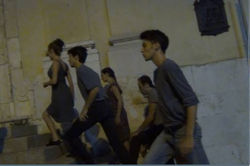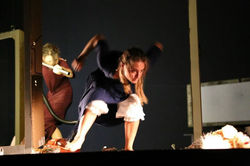 |  |  |  |
|---|---|---|---|
 |  |  |  |
 |  |  |  |
 |  |  |  |
 |  |  |  |
 |  |  |  |
 |  |  |  |
 |  |  |  |
 |  |  |  |
 |  |  |  |
 |  |  |  |
 |  |  |  |
 |  |  |  |
RURAL AND URBAN RESIDENCES
Residence as promotion of the territory, as exchange, experimentation, research. Residence as a place of artistic and human formation.
"The human body becomes a" navigator "in the complex system of communicative geographies of the city where the languages of art interact in a continuous territory of exchange where technology and poetry dictate the coordinates of the paths of new urban wandering”.
Starting from this definition of the concept of residence, the focus shifts to a redefinition of the relationship between BODY AND SPACE and the concept of DECENTRALIZATION OF ART from a spatial and consequently social and economic point of view.
SPACES AND PLACES
If the urban space becomes the theater of daily life, the city becomes, in this sense, a "found" space, in which the actors, or performers, must interpret the space with its physical and social limitations.
"The use of space is not neutral, and the functional and aesthetic organization of theaters and cities proves it. In "alternative" theatrical places, the bare walls, or the performance of the structure of the scene that highlights the "theatrical fiction" (Schechner, 1968, 45), and moreover their unusual location that makes us forget the symbol theater, contrasts that sort of "fetishism" of the staging which, for example, hides the walls of the stage backdrop with sumptuous scenographies, in a similar way to that "commodity fetishism" through which, according to Marx, "money and the market drop a 'mask' the social relationships between things "(Harvey, 1990, trad. it. 2002, p. 129). Moreover, in traditional theaters there is a rigid separation of access for the public and for artists, so, again according to Schechner (1984, 122), "an expedient to separate the production of goods from their trade, is to hide all preparations for buyers “.
Very often, however, it is not possible to find this separation in alternative theatrical spaces, in which the social and consumer relationships that are established both between the artists and the audience, can be very different, more horizontal and less codified, than happens for the use of the shows in a conventional theater.
What has been said so far also requires reflections on the phenomena of public mobility, and therefore on the ways of appropriating certain cultural resources distributed unevenly across the territory.
RELATIONSHIP WITH THE USERS
Decentralizing art - also from an economic, as well as social and spatial point of view - means acting on people's cultural practices and experiences, in order to make livable (in all senses) not only the city but also that cultural part - increasingly significant - of its service offering. The decentralization of art therefore proposes a virtuous development model, based on the ability to invest in the relationship with the audience, in order to increase the advantages and opportunities of exchange and comparison.
A development model that focuses on the responsibility of organizations towards the goals of involvement and synergy with the territory, and, above all, on the ability to generate networks of mutuality in the territory and to convey those values capable to bring a substantial improvement in quality of life in the community. A strategic behavior that believes that cultural production must necessarily measure itself against the patient construction of an impact on the communities by paying more attention to the needs of its residents and at the same time learning to detect and react to them.
ALTERNATIVE THEATER SPACE IN TERMS OF A DIALOGUE WITH THE SURROUNDING URBAN ENVIRONMENT
The architecture of the so-called "alternative" theatrical spaces is connected to their location in the urban space as a qualifying element from the symbolic and social point of view, but in a very different way from the historical theaters or in any case from the more or less general and shared idea of what is a theater. These spaces are born with a utilitarian purpose (for example a former workshop), and often arise in decentralized areas, normally assigned to other activities, almost always non-cultural, linked to the mobility, residence or service mechanisms of the urban community. The contemporary urban environment is strongly marked before the hegemony of Italian-style theaters - the type of show building predominant in European culture from the 16th to the 19th century - and then by the loss of meaning of the institution-building as a norm. The American director and anthropologist Richard Schechner speaks of theaters "with the proscenium" referring to the spatial structure derived from the Italian theater, internally structured by the elements that define and separate the hall and the scene (Schechner, 1984, pp. 121-123). As for the interior, in fact, a first difference between traditional and alternative spaces lies precisely in this architectural separation, rigid and culturally codified, made possible by the proscenium arch.
Moreover, in the XX century alternative spaces became a point of reference for those artists who, refusing the ordinary canonical structure of the Italian theater, "frontal, distancing, unchangeable", were induced "to abandon the old theatrical buildings but not so much to enter new theatrical buildings" - this is the significant figure - "as to devote themselves to the use or reuse of non-theatrical spaces: sheds, warehouses, garages, cellars, deconsecrated churches; and then open places: squares, streets, courtyards, etc. Rather, being on the margins means being decentralized with respect to a conventional theatrical system. Sometimes we could also refer to the fact that they target less extensive audiences. In theaters, therefore, there are particular artistic-aesthetic and "institutional" conventions determined by the codes used in theatrical communication and by particular proxemic conditions, which suggest how to behave in the space where you are, and above all communicate a particular “situation”.
TERRITORY NECESSARY
An examination of the territory with respect to the distribution of theatrical rooms would allow us to grasp both the aspects related to the organization of this activity, and the artistic and aesthetic dimension of it, as well as the social and cultural uses that its insertion in the urban structure entails. The position in the city is an important element of the identity of a theater and is in fact "decisive in the attitude of the public" with respect to it and its programming, together with the characteristics of the building, the capacity and finally the history and tradition of the room. In fact, in the chronological and geographical extension of the events that have been taken on as a theater, it should be noted that there are very limited numbers of those pertinent to the theater building as a place equipped and designed specifically for shows. Instead we find theater in fairs, in markets, in the gathering spaces of a community; in places of worship, in churches and in churchyards; in the squares, in the streets, in the courtyards. So, together with theaters as clearly identifiable physical places, it is the same organization of urban space, yesterday as today, that often acts as the territory of theatrical performances.
THE "TRANSFORMED SPACES"
The "spaces found" will generally be environments and places (indoors and outdoors) more or less strongly marked and structured from an architectural and / or urban point of view: the interior of a church, the hall or the courtyard of a ancient building, a cloister, a square, a street ". Among these places, however, there are also the disused peripheral industrial spaces, "places of industrial archeology, such as old factories", that is, spaces strongly connoted symbolically, such as the Lingotto of Turin, used by Luca Ronconi in 1991. Many of the examples cited so far show what kind of relationship can exist between a former factory, such as the Turin Lingotto or like the old Mira Lanza factory, now home to the Teatro India in Rome (“Scenic location alternative to the Italian theater “), and the adjacent area, the result of cultural and urban rethinking that highlight a gap with the city-consumption, now exemplified by the redeveloped historic center - except for the interstices already mentioned - and by the shopping centers. Some of these initiatives fall within more or less relevant cultural and social projects, supported by local institutions, such as municipalities, with the purpose of social redevelopment and functionality of areas of the city.
PERSONAL EXPERIENCE
As an example and testimony of what has been said, in my personal experience I can include the MULTI-ANNUAL CONTEMPORARY DANCE “ARCHEODANZA” PROJECT among the various residency projects hosted or / and co-produced. (which was born with the production of Il Secchio d'Abete by La Signora delle Vigne by Ghiannis Ritzos, represented in its first version within the Nuragic complex of Barumini Su Nuraxi, _ entered since 1997 on the UNESCO World Heritage List).
The places that host contemporary dance identify themselves as “logos”, or cultural identities with the dual purpose of telling and welcoming the project / residence. It is an artistic project based on the contamination between visual art, historical-cultural heritage and live entertainment. The itinerary of the residences and shows takes place among ancient archeologies in a project to promote and enhance the historical heritage.
ARCHEODANZA was born in 2006 as an extension of the ten-year urban project DANZARCHITETTURE and both projects called "ARTISTIC SITES", emphasize the contemporary value of the "walls", intended as "former place", place to defend the culture and history of the city, more precisely to preserve our culture and memory, and again, both projects underline the goal of training and raising awareness among the young public and adults, through active participation in particular places for their preciousness and the activation of different forms of design and intervention, which involves artists from different backgrounds. The national - transnational diffusion of the experience of the creative process places the emphasis on the different cultural methodologies. The circulation of the works produced within the Spazio T.off mother worksite - container of the residence activity - takes place through highly spread communication channels such as: - seminars, conferences, reviews, festivals, website and using the language of video docu // film as a communication tool. This allows to extend the research and the cultural product that will not end in space and time related to the duration of the project, but will open up to the continuous generation of the multicultural dimension, even beyond the borders of the territory of Sardinia.
ARTISTIC RESIDENCIES
Officina delle arti sceniche e performative

